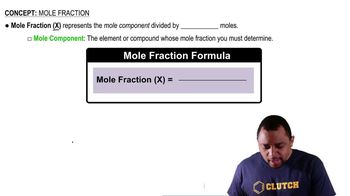Here are the essential concepts you must grasp in order to answer the question correctly.
Mole Fraction
Mole fraction is a way of expressing the concentration of a component in a mixture. It is defined as the ratio of the number of moles of a specific component to the total number of moles of all components in the mixture. This dimensionless quantity helps in understanding the composition of gas mixtures and is crucial for calculations involving partial pressures and gas laws.
Recommended video:
Ideal Gas Law
The Ideal Gas Law relates the pressure, volume, temperature, and number of moles of a gas through the equation PV = nRT. This law is fundamental in understanding the behavior of gases under various conditions and is often used to derive relationships between different gas properties, including how to calculate the mole fraction when dealing with mixtures.
Recommended video:
Partial Pressure
Partial pressure is the pressure that a single gas in a mixture would exert if it occupied the entire volume alone. According to Dalton's Law of Partial Pressures, the total pressure of a gas mixture is the sum of the partial pressures of each individual gas. Understanding partial pressures is essential for calculating mole fractions, as they can be directly related to the mole fraction of each gas in the mixture.
Recommended video:
Partial Pressure Calculation





